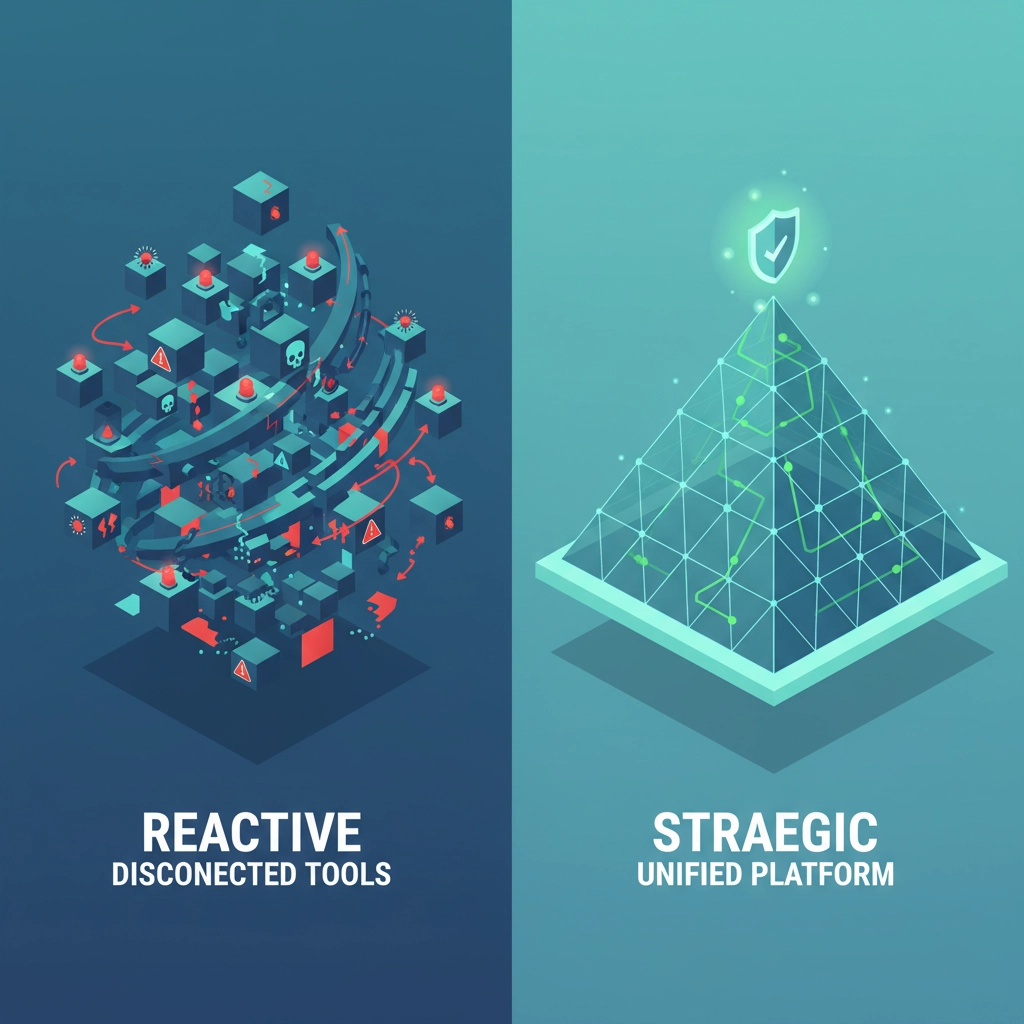Every week, another "game-changing" cybersecurity solution hits the market. Your competitors are supposedly investing in AI-powered this and zero-trust that. Meanwhile, your inbox is flooded with vendor pitches promising to solve all your security problems with their revolutionary platform. Sound familiar?
You're not alone. 76% of companies are increasing their software budgets by 5-15% this year, and much of that spending is driven by one thing: the fear of missing out. But here's the uncomfortable truth – most of these investments are burning money faster than they're protecting businesses.
The pressure to "keep up" has created a dangerous cycle where fear, rather than strategy, drives IT spending decisions. And cybersecurity budgets are getting hammered the hardest.
The Real Cost of FOMO-Driven IT Decisions
Let's talk numbers. Recent data shows that only 25% of AI-powered security initiatives deliver their expected return on investment. That means three out of four businesses are essentially throwing money at problems without solving them.
But the real cost isn't just the upfront purchase price. It's the hidden expenses that pile up afterward:
- Training costs nobody budgeted for
- Integration nightmares that take months to resolve
- Overlapping tools that do the same job differently
- Abandoned software that seemed essential six months ago
The typical scenario plays out like this: You hear about a threat at a conference, read about a competitor's new security stack, or get spooked by a headline. Within weeks, you're signing a contract for a solution you haven't fully evaluated, don't completely understand, and aren't sure how to implement.

Why Cybersecurity Budgets Get Hit Hardest
Cybersecurity presents unique challenges that make it especially vulnerable to FOMO-driven spending mistakes. Unlike other IT investments, security doesn't come with clear, immediate ROI metrics. You can't easily point to increased sales or obvious efficiency gains.
This creates several problems:
The "Better Safe Than Sorry" Trap: Fear of a breach drives businesses to over-invest in overlapping solutions. You end up with five different tools that all claim to do endpoint protection, each with its own management console and learning curve.
Vendor Fear Tactics: Security vendors are masters at selling fear. They'll show you the latest attack statistics, highlight your vulnerabilities, and position their solution as the only thing standing between you and disaster.
The Complexity Problem: The cybersecurity market is flooded with thousands of solutions. Every vendor claims their approach is revolutionary, making it nearly impossible to separate genuine innovation from marketing hype.
Communication Gaps: IT teams struggle to translate cybersecurity needs into financial terms that CFOs understand. This leads to either under-investment (because the business case isn't clear) or panic spending (when a threat feels immediate).
The result? Businesses end up with fragmented security postures that are expensive to maintain but don't actually work together effectively.
The Strategic Alternative: Risk-Based Investment
Smart businesses are taking a fundamentally different approach. Instead of reacting to every new threat or competitor move, they're building cybersecurity strategies based on actual business risk.
Here's how the mindset shift works:
From Reactive to Proactive: Rather than waiting for the next scary headline, assess your specific vulnerabilities first. What assets are most critical to your business? Where are your actual weak points?
From Tool-Focused to Outcome-Focused: Instead of asking "Should we buy this security tool?", start with "What security outcome are we trying to achieve?" Then find the most cost-effective way to get there.
From Fear-Driven to Data-Driven: Base decisions on actual risk assessments, not vendor presentations or competitor anxiety. What threats are most likely to affect your specific industry and business model?

Your 5-Step Framework for Smart Cybersecurity Spending
Here's a practical framework to break the FOMO cycle and start making strategic cybersecurity investments:
Step 1: Conduct a Real Risk Assessment
Before spending a dollar, understand what you're actually protecting. This isn't about checking compliance boxes – it's about identifying your most critical assets and most likely threats.
Ask these questions:
- What would shut down our business for days or weeks?
- What customer data do we handle, and what are our legal obligations?
- Which systems, if compromised, would damage our reputation?
- What compliance requirements do we actually need to meet?
Step 2: Map Your Current Security Posture
Take inventory of what you already have. Many businesses discover they're paying for overlapping solutions or underutilizing existing tools that could solve their problems with proper configuration.
Create a simple spreadsheet listing:
- All current security tools and their costs
- What each tool is supposed to do
- How much of each tool's capability you're actually using
- Gaps that remain uncovered
Step 3: Prioritize Based on Business Impact
Not all risks are equal. A data breach might be catastrophic for a healthcare company but merely inconvenient for a manufacturer. Prioritize investments based on:
- Probability of occurrence in your specific industry
- Potential business impact if the threat materializes
- Cost of prevention versus cost of remediation
- Regulatory requirements that carry financial penalties
Step 4: Evaluate Solutions Against Clear Criteria
Before evaluating any security solution, establish clear criteria. For each potential investment, ask:
- Does this address a risk we've identified and prioritized?
- How will we measure success?
- What's the total cost of ownership, including training and maintenance?
- How does this integrate with our existing tools and processes?
- What happens if this vendor goes out of business or discontinues the product?
Step 5: Plan for Implementation Success
Most cybersecurity investments fail during implementation, not because of the technology itself. Budget for:
- Staff training – plan for weeks, not hours
- Integration time – assume it will take longer than promised
- Change management – your team needs to actually use the tools
- Ongoing maintenance – security isn't "set and forget"

Making It Work: Implementation That Actually Delivers
Even the best security tool is worthless if your team doesn't use it correctly. Here's how to avoid the implementation trap:
Start Small and Scale: Rather than rolling out enterprise-wide immediately, pilot new security tools with a small team. Work out the kinks before expanding.
Invest in Training: Budget at least 20% of your tool cost for proper training. This isn't just a one-time expense – plan for ongoing education as threats evolve.
Measure and Adjust: Establish clear metrics for success before implementation. Are you reducing incident response time? Catching more threats? Improving compliance scores?
Plan for Integration: Security tools that don't talk to each other create blind spots. Ensure new investments integrate with your existing security stack.
The goal isn't to have the most advanced security tools – it's to have a security posture that effectively protects your business at a sustainable cost.
Turn FOMO Into Strategic Advantage
The businesses that resist FOMO-driven spending aren't just saving money – they're building more effective security programs. While competitors chase every new trend, strategic companies focus on fundamentals that actually work.
This disciplined approach creates a compound advantage over time. Better security outcomes with lower costs. Fewer vendor relationships to manage. Staff who actually understand the tools they're using.
Ready to break the FOMO cycle and start making strategic cybersecurity investments? Contact B&R Computers for a no-obligation assessment of your current security posture. We'll help you identify the gaps that actually matter and develop a budget that protects your business without breaking the bank.
Don't let fear drive your next cybersecurity decision. Let's build a strategy that actually works.




































































































